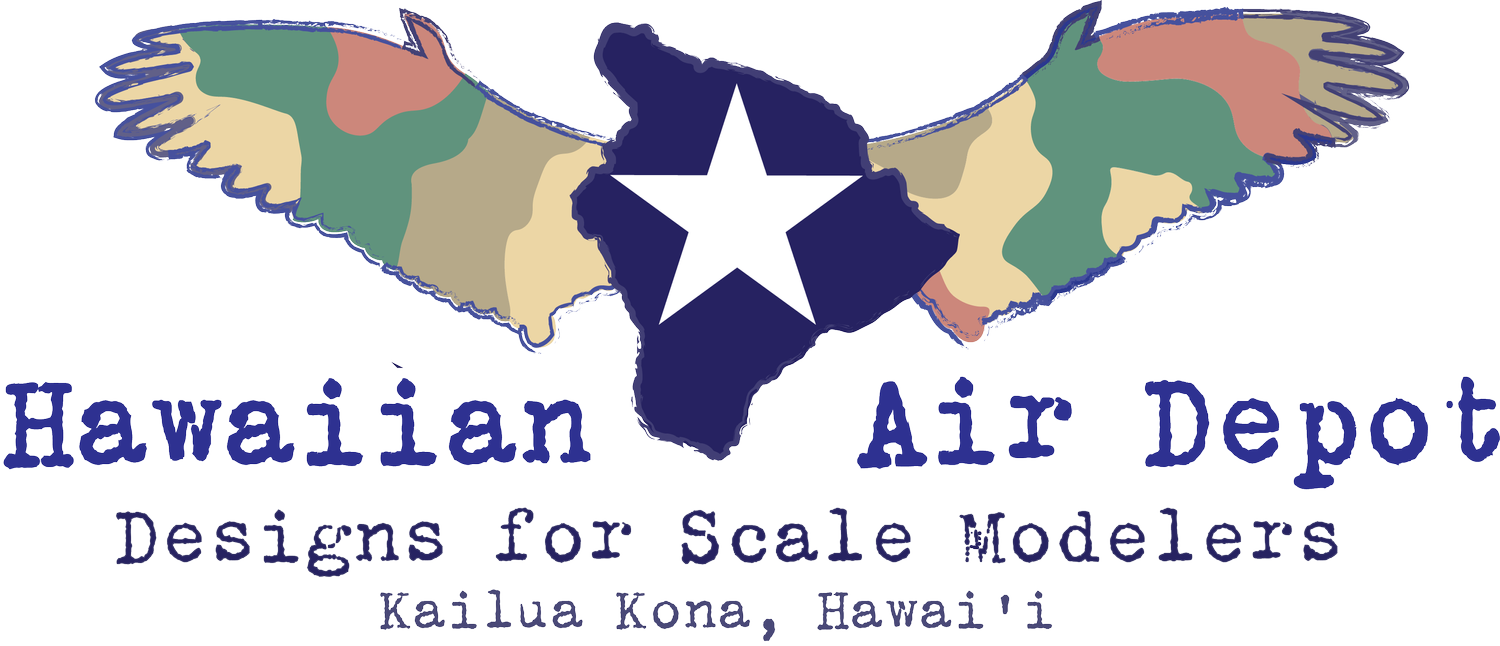Who Makes the Best Masks? You Do.
Precut painting and canopy masks are available from several manufacturers, and generally they are very good. We would never have become interested in Making Our Own if not for excellent experiences with products from Eduard, Maketar, Montex, and a few others.
But material and logistical costs limit the scope of how precut masks are designed. That’s why we started Hawaiian Air Depot. Downloadable files that modelers produce themselves offer some innovations and options you won’t find anywhere else.
A big one is the completeness and complexity of the design. Take insignia: rather than just a cutout on a rectangular background, HAD masks are typically comprised of four components— an Alignment Mask, a Base Mask, a Finish Mask, and an Overspray Mask. Here’s an example from our 1/32 Tamiya Spitfire Essential Mask set:
The Alignment Mask protects the area around the marking to be painted from overspray, but also serves another important function. You’ll see they are irregularly shaped; thats because they are designed to help position and align the marking. The edges of the masks match panel lines and edges of parts from the kit they are designed to fit. Align these edges and the marking will be positioned just where factory drawings and period photographs show them to be. Read more about how we create or designs here.
And what if the subject you are modeling has an atypical placement? Comparing the mask edges to the panel lines, you can manually adjust the position to wherever you need it.
The Base Mask looks pretty much like the marking you are trying to paint, but closer inspection makes it seem a little wonky or out of proportion. Don’t worry, you aren’t crazy. It is, and it’se supposed to be. Base Masks are designed to allow a slight overspray of the initial colors— usually the lightest ones of the marking— so there aren’t any unpainted edges where one color meets another. Once the lightest colors are painted, the Base Mask is removed and the elements of the Finish Mask are applied. And if you prefer to eliminate the step, the Base mask may be immediately replaced by the Finish Mask. Now it will perform like a more traditional product.
The Finish Mask is the one that is carefully designed to the measurements and proportions of the actual marking. Its edges slightly overlap the base colors, resulting in the correct appearance of a multi-colored marking.
The Overspray Mask allows you to mask your completed marking to paint or weather around it.
With all those parts, modelers can mix and match them whatever painting strategy they like. If you prefer you can start with a base of the light color and overcoat the darker ones. For one-color markings you can paint the camouflage first then apply a mask to paint the marking, or you can place a mask over a base coat of the marking color, then paint the camouflage around it. We designed our 1/24 F6F-5 Hellcat insignia just that way:
But we recommend you try the mask system in the according to our preferred process. Why? Mostly because we love all the amazing and fine surface detail on today’s best kits. We hate clogging it up with 4 or 5 coats of paint.
Our system allows you to paint your own markings and camouflage with only a single layer of paint over the bare plastic or primer. It requires a few more steps, but the results are well worth it. Here’s how it works, again using the Spitfire roundel:
After placing the Alignment/Base Mask by matching the red edges to the kits parts, remove the yellow and white portions of the base mask. Paint the yellow and white.
Remove the rest of the Base Mask and apply the main element of the Finish Mask in its place. Then remove the center circle so the red can be sprayed.
Another circle is provided to mask over the red. Then remove the outer ring of the Finish Mask to paint the blue.
With all the colors painted and the rest of the Finish Mask removed, position the Overspray Mask over the completed roundel, then remove the Alignment Mask. Paint the surrounding camouflage. Viola. All the markings and camo painted without a second layer of paint over any portion. All those beautiful rivet and panels are ready for your favorite finishing and weathering techniques.
No matter how you choose to paint your next project a Hawaiian Air Depot design will have everything you need to do it just the way you like.



